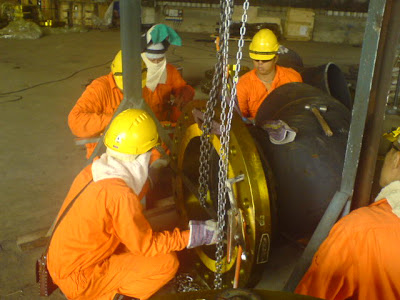originally posted on remsauce.blogspot.com
 Pipeline 24" and 20"
Pipeline 24" and 20" MLNG 3 from the outside.
MLNG 3 from the outside.Oil and Gas: Fabrication vs Processing
When we talk about oil and gas industry in Malaysia, we will always picture those big names such as Shell and Petronas. These companies are among the richest company in the whole world. Their incomes are totally huge as the oil price is increasing steadily over the decades. Almost everyone has the prospect to get involve with these companies, of course because of the income factor. But, do you realize that the company target is more to oil and gas processing?
I tell you something.
I tell you something.
There is actually other alien field but directly links to oil and gas industry. There is a field of fabrication for piping, mechanical vessel, tanks, steel structures and the plant station.
Now you realize it.
 Welder
WelderThere are several companies in Malaysia which do the fabrications for the offshore platforms, oil and gas terminal, plant and so on. These names are various and some even hold the stake at Papan Pertama Bursha Saham such as Kencana. There are more oil and gas fabrication company we can see around Sarawak, Labuan and Terengganu, such as Sarku, Dayang Enterprise and Dialogue.
I must tell you that,
in oil and gas fabrication field, we are dealing with several workers, in which the most important is the piping welders. They are supposed to do their welding according to some very high standard of American Petroleum Institute, a standard of oil and gas used in the whole world. Well, you know what happen if they are lack of skills and ability of welding; the piping may leak and explode.
 Welder
WelderThere are also the pipe fitters that extract the information from the piping drawing, and prepare the pipes to be weld. They will select the pipes, the fittings and everything, and put them into place, and let the welder do the welding.
 Pipe Fitters
Pipe FittersThere are also workers called as rigger. Their specific task is to do the lifting or swinging of pipes, instruments and other things as well. They mostly collaborate with the cranes, trailer and other.
Other workers involved are the helpers. Some of them do the grinding, the cutting, and help the welder, fitters and the rigger.
Other workers involved are the helpers. Some of them do the grinding, the cutting, and help the welder, fitters and the rigger.
 Rigger
RiggerWell, fabrication for oil and gas industry is quite rare. That is why most of the fabrication company also involved in maintenance for oil and gas. No fabrication means no money, but with their involvement for maintenance, they will at least survive. No need to worry about the income. Every year, there are thousands of oil and gas repair projects, whether it is onshore or offshore. Beside repair projects, there are also oil and gas upgrading project or even erecting a new plant.
I talked to several welders.
Most of them already went to offshore to do the welding for oil and gas platform. Most of them also do the repair for platform piping and structural.
It means that fabrication, maintenance and upgrading for oil and gas also as much as important as the oil and gas processing.
Oil and Gas : Fabrication vs Processing. *seri*
Additional Facts:
1. Fabrication Companies are Contractors.
2. Contractors are working at site, where the projects are. Meaning, they are travelers.
3. Travelers are mostly away from home. They have their total freedom. Most of the workers are man.
4. At the day, they work. At the night, they play. According to them, Labuan is still their best place for them to play: the beer is cheap, the night-shift-girls are friendly, and where everyone is the boss.
5. Processing Companies are attached to a place.
6. They will work according to their specific working hours.
7. They are not away from home. They are not travelers. They are not gaining total freedom because everyone they know keeps track of them.
8. Their best place to play is at home.
1. Fabrication Companies are Contractors.
2. Contractors are working at site, where the projects are. Meaning, they are travelers.
3. Travelers are mostly away from home. They have their total freedom. Most of the workers are man.
4. At the day, they work. At the night, they play. According to them, Labuan is still their best place for them to play: the beer is cheap, the night-shift-girls are friendly, and where everyone is the boss.
5. Processing Companies are attached to a place.
6. They will work according to their specific working hours.
7. They are not away from home. They are not travelers. They are not gaining total freedom because everyone they know keeps track of them.
8. Their best place to play is at home.
































































